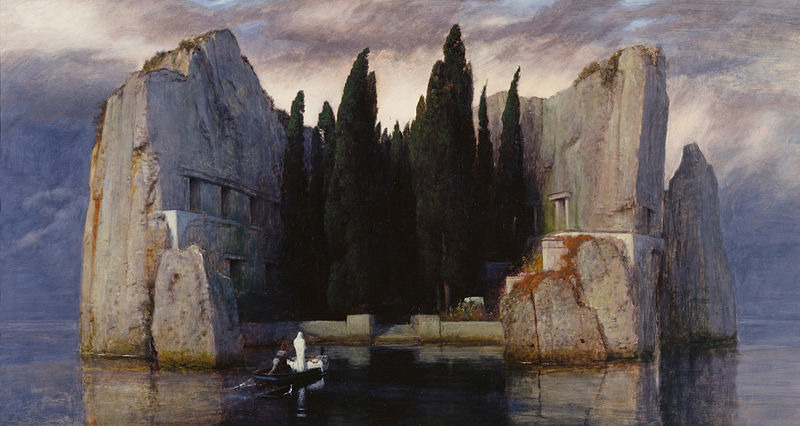
Böcklin: Die Toteninsel, 3rd version, 1883
As you say the Latin aloud, you can hear that it’s very emphatic – 8 syllables per line. This early English translation also keeps this 8-syllable structure. Read it aloud emphasizing every syllable and you’ll start to get an idea of how powerful some of the musical settings could be:
Di-es i-rae, di-es il-la / Day-of-wrath-and-doom-im-pen-ding.
| 1 2 3 19 | Dies iræ! Dies illa Solvet sæclum in favilla: Teste David cum Sibylla! Quantus tremor est futurus, Quando iudex est venturus, Cuncta stricte discussurus! Tuba mirum spargens sonum Per sepulchra regionum, Coget omnes ante thronum. … Pie Iesu Domine, dona eis requiem. Amen. | Day of wrath and doom impending, David’s word with Sibyl’s blending, Heaven and earth in ashes ending! Oh, what fear man’s bosom rendeth, When from heaven the Judge descendeth, On whose sentence all dependeth. Wondrous sound the trumpet flingeth; Through earth’s sepulchres it ringeth; All before the throne it bringeth. … Lord, all-pitying, Jesus blest, Grant them thine eternal rest. Amen. |
This is just the first 3 verses; there are another 15 that follow until the couplet ending.
Pro Cantione Antiqua , Mark Brown, cond.
Since this was both rhythmically and melodically memorable, composers began to use the ‘Dies Irae” as a marker for things having to do with the dead.
When you listen to the music, you will start to hear a couple of important musical ideas just in the first few seconds: the music has an intertwining descent (it goes down, goes back up, goes down, goes back up, etc.) and then ends in a descending scale. This is just the first few seconds of the chant. Listen to just the beginning of the chant a few times and then listen to a little bit of Liszt that follows and you’ll start to see how composers used this musical idea.
Franz Liszt, in his Totentanz (Dance of Death), signals this fatal dance from the beginning of his piece: the piano has crashing chords and then the orchestra enters with the ‘Dies Irae.’
Liszt: Totentanz
In 1909, Rachmaninoff wrote his eerie symphonic poem, The Isle of the Dead, based on a painting by the Arnold Böcklin, depicting Charon, the mythological ferryman of the dead crossing the River Styx, rowing a body in its white shroud to the Island of the Dead.
Rachmaninoff: The Isle of the Dead, Op. 29
Throughout the work, Rachmaninoff uses fragments of the ‘Die irae’ melody and, as you familiarize yourself with the melody, you’ll hear more and more of it in this piece as the more you listen. The most recognizable fragment is the initial intertwining notes we listened to above. The piece is quite ethereal – beginning slowly and quietly. It rises to a climax as Charon delivers his passenger to the Island of the Dead and then subsides again as the deathly ferryman returns to his start.
In his intensely introspective Symphonie Fantastique, Hector Berlioz uses the ‘Dies Irae’ in a distorted manner in the final movement to show both the grotesqueries of his imaginings of scene and the fatality of his vision. We’ll explore his vision later in this series.
